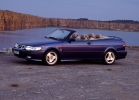technical characteristics of Saab 9-3 Aero Cabriolet 1999 - 2003 convertible
Technical characteristics of the Saab 9-3 Cabriolet 1999, 2000, 2001, 2002, 2003: power, fuel consumption per 100 km, weight (mass), road clearance (clearance), radius of reversal, type of transmission and brakes, body size and tires
Engine characteristics
| Modifications |
Engine volume, cm3 |
Power, kW (lp)/about |
Cylinders |
Twisting, Nm/(rpm) |
Type of the fuel system |
Type of fuel |
| 2.0 Turbo (205 hp) |
1985 |
151(205)/5500 |
L4 (in -line location) |
280/2200 |
Multiple injection |
Petrol |
Drive and transmission
| Modifications |
type of drive |
Type of transmission (basic) |
Type of transmission (optionally) |
| 2.0 Turbo (205 hp) |
Front-wheel drive |
5-MKPP |
|
Brake system and steering wheel amplifier
| Modifications |
Type of front brakes |
Type of rear brakes |
Power steering |
| 2.0 Turbo (205 hp) |
Ventilated discs |
Disk |
there is |
The size of the tires
| Modifications |
The size |
| 2.0 Turbo (205 hp) |
205/50 WR16 |
Dimensions
| Modifications |
Length, mm |
Width, mm |
Height, mm |
The track front/back, mm |
Wheel base, mm |
Road clearance (clearance), mm |
Trunk volume, l |
| 2.0 Turbo (205 hp) |
4630 |
1709 |
1430 |
1450/1440 |
2601 |
150 |
294 |
Car weight
| Modifications |
Equipped mass, kg |
Maximum mass, kg |
Lifting capacity, kg |
| 2.0 Turbo (205 hp) |
1365 |
1810 |
445 |
Dynamics
| Modifications |
Maximum speed, km/h |
Acceleration time to 100 km/h, with |
CD (frontal resistance coefficient) |
| 2.0 Turbo (205 hp) |
235 |
7.3 |
0.28 |
Fuel consumption
| Modifications |
In the city, l/100 km |
On the highway, l/100 km |
Average consumption, l/100 km |
Extrication CO2, g/km |
Type of fuel |
| 2.0 Turbo (205 hp) |
14 |
7.1 |
9.6 |
236 |
Petrol |






